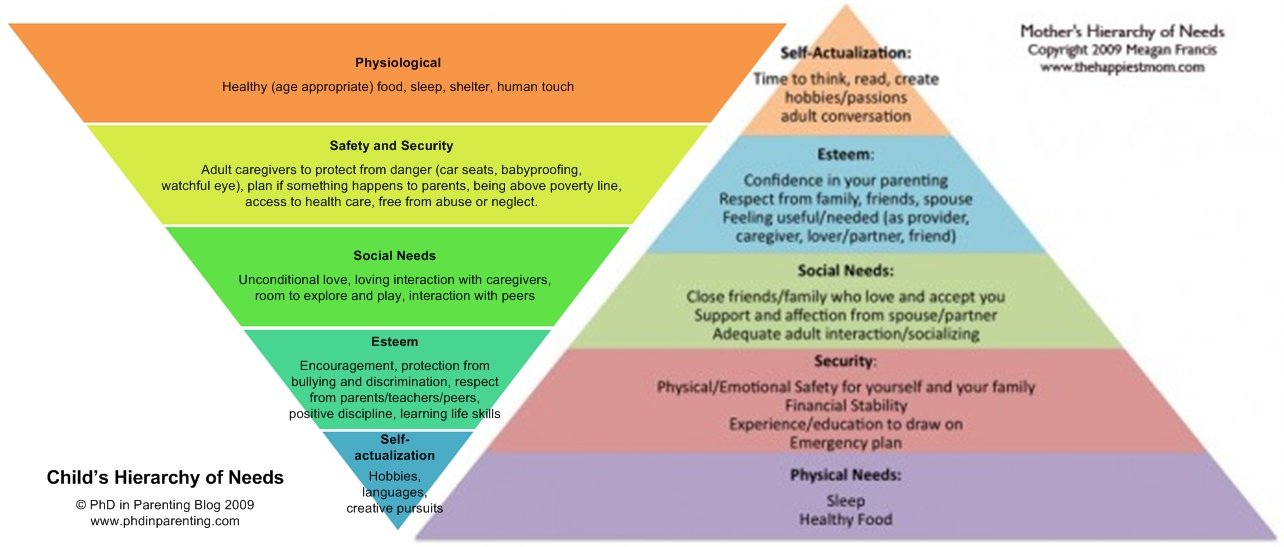The Intersecting Needs of Mothers and Children
Why Meeting Your Own Needs Is Part of Parenting
Have you ever found yourself snapping at your child for something small — then feeling guilty right after?
Or trying to play dolls or build Lego while every fibre of your being just wants quiet, space, and a nap?
You’re not failing.
You’re probably just running on empty.
And this image — a side-by-side of a Child’s Hierarchy of Needs and a Mother’s Hierarchy of Needs — explains exactly why.
It reminds us of a powerful truth:
✨ A parent’s needs don’t disappear when a child’s appear.
✨ And when our needs go unmet for too long, we can’t meet theirs well — and that’s okay.
Let’s explore how this plays out in real life, and why tending to yourself is one of the most child-centered things you can do.
🔺 The Pyramid of Needs — For Kids and Parents
Maslow’s hierarchy of needs is a pyramid model that shows how humans must first meet basic survival needs before they can reach emotional growth or fulfillment.
The left side of this image shows the Child’s Hierarchy of Needs: food, safety, love, learning, and creativity.
The right side shows the Mother’s Hierarchy of Needs: rest, safety, connection, confidence, identity.
And the most important insight?
These needs are interconnected.
A child’s need to feel safe, seen, and soothed depends deeply on a parent’s ability to regulate, connect, and co-create structure.
And we can only do that consistently when we’re getting our own needs met too.
💡 Real Life Examples of This in Action
💤 You Haven’t Slept
You’re surviving on four hours of broken sleep.
Your toddler wants to play pretend for the fifth time today, or your teen is melting down over a maths test.
❌ You can’t focus.
❌ You can’t access your empathy.
❌ You feel irritated, disconnected, guilty.
✔️ What this means: You’re stuck in your own base-level needs (physiological survival).
Trying to meet your child’s social or esteem needs — like being emotionally present or offering encouragement — may be out of reach right now. And that’s okay.
✅ What helps: Lower expectations. Tag team if possible. Take a screen break. Sit beside your child instead of joining in. Be honest and say:
“I’m really tired today, so I can’t play right now — but I’m glad we’re together.”
🔊 You’re Overtouched and Overstimulated
You've been clung to, talked at, poked, hugged, cried on, and climbed. Your nervous system is shot.
Your child now wants to sit on your lap, or is bouncing around the living room.
❌ You flinch. You get snappy. You want to be left alone.
✔️ What this means: You’re in sensory and emotional overload.
Your child may be seeking touch, connection, or stimulation, but your system is screaming “no more input!”
✅ What helps: Pause. Breathe. Say:
“I love you so much, and I need a few minutes of quiet so I can feel okay again.”
Offer a sensory substitute: “Let’s sit side by side while I rest” or “Can you hug your teddy while I stretch my arms?”
🧠 Why This Isn’t Selfish
We often hear “You can’t pour from an empty cup.”
But this image makes that metaphor visible — and layered.
Because:
🧠 A child can’t climb their pyramid (toward confidence and creativity)
📉 If their parent is stuck at the base (exhausted, overwhelmed, disconnected).
And:
🧠 A parent can’t respond calmly to a child’s meltdown
📉 If they are running on no sleep, no support, and no space to breathe.
Meeting your needs doesn’t mean ignoring theirs.
It means supporting theirs sustainably.
💬 What Can You Do?
Check your own pyramid. What tier are you stuck on?
Normalize the struggle. Some days all we can do is meet the bottom two needs. That’s okay.
Share the load. Tag in a partner, friend, or safe support where possible.
Simplify your expectations. Connection doesn’t always look like play or praise — sometimes it’s presence.
Let go of guilt. Your child doesn’t need perfection. They need a parent who listens to themselves.
❤️ Final Thought
This pyramid doesn’t tell you to put yourself first.
It tells you that you’re part of the equation.
Parenting isn’t just about responding to your child — it’s about supporting the system you both live in.
And that system includes your sleep, your space, your joy, your safety.
When you tend to your needs, you’re not stepping away from your child — you’re stepping toward sustainability, presence, and connection.
And that, more than anything else, is what builds secure, thriving kids.
